Portland, Maine 作者: 来源: 发布时间:2021-11-08
I.Population and Area
₋Area
Land: 21.31 sq mi (55.19 km2)
₋Population
Total: 66,194
Density: 3,147.21/sq mi (1,215.2/km2)
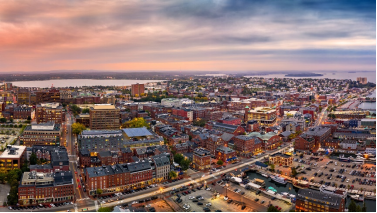
II.Natural Geography
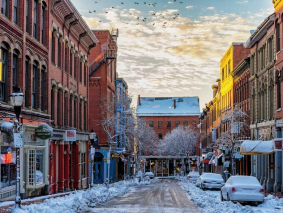
Downtown Street
₋Portland is the most populous city in the U.S. state of Maine and the seat of Cumberland County. Portland's population was 66,215 as of 2019. The Greater Portland metropolitan area is home to over half a million people, more than one-third of Maine's total population, making it the most populous metropolitan area in northern New England (an area comprising the states of Maine, New Hampshire, and Vermont) and the 105th-largest in the United States. Portland's economy relies mostly on the service sector and tourism. The Old Port district is known for its 19th-century architecture and nightlife. Marine industry still plays an important role in the city's economy, with an active waterfront that supports fishing and commercial shipping. The Port of Portland is the largest tonnage seaport in New England.
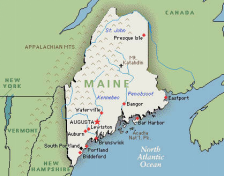
₋The city seal depicts a phoenix rising from ashes, a reference to recovery from four devastating fires. Portland was named after the English Isle of P ortland, Dorset. In turn, the city of Portland, Oregon was named after Portland, Maine. Portland itself comes from the Old English word Portlanda, which means "land surrounding a harbor".
III.ECONOMY
₋The average salary in Portland, ME is $61k. Trends in wages increased by 2.0 percent in Q1 2020. The cost of living in Portland, ME is 13 percent higher than the national average. The most popular occupations in Portland, ME are Project Manager, (Unspecified Type / General), Operations Manager, and Software Engineer which pay between $39k and $106k per year. The most popular employers in Portland, ME are Maine Medical Center, Idexx Laboratories, Inc., and MaineHealth.
₋Website: https://www.payscale.com/research/US/Location=Portland-ME/Salary
IV.Industrial Characteristics
₋Portland has become Maine's economic capital because the city has Maine's largest port, largest population, and is close to Boston (105 miles to the south). Over the years, the local economy has shifted from fishing, manufacturing, and agriculture towards a more service-based economy. Most national financial services organizations such as Bank of America and Key Bank base their Maine operations in Portland. Unum, TruChoice Federal Credit Union, People's United Bank, ImmuCell Corp, and Pioneer Telephone have headquarters here, and Portland's neighboring cities of South Portland, Westbrook and Scarborough, provide homes for other corporations including IDEXX and WEX Inc. Since 1867, Burnham & Morrill Co., maker of B&M Baked Beans, has had its main plant in Portland and is considered a landmark.
₋The city's port is also undergoing a revival and the first-ever container train departed from the new International Marine Terminal with 15 containers of locally produced bottled water in early 2016.
₋Americold, a US-based international provider of temperature-controlled storage and distribution, won a bid to develop a state-of-the-art temperature-controlled storage facility adjacent to the port. The facility will support perishable produce, meats, and seafood imports with direct exports but construction has not yet begun.
₋Portland has a low unemployment rate (3% in June 2017) when compared to national and state averages. The city and its adjacent communities also have higher median incomes than most of the state.
₋In January 2020 Portland was announced to be the location of a new research institute that will focus on the application of artificial intelligence and machine learning. Northeastern University was selected by technology entrepreneur David Roux to lead the institute that will include programs that will allow graduate student research.
₋Portland also has a large subsidized housing industry with more than five large real estate companies entirely in the business.
V.Attractions
1.Portland Head Light
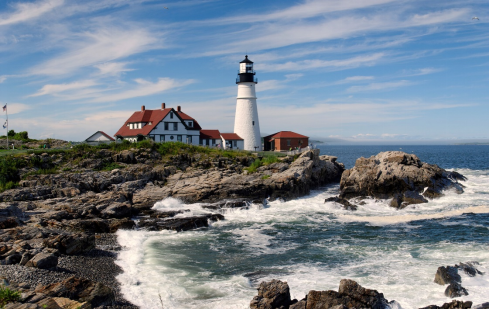
₋Portland Head Light is a historic lighthouse in Cape Elizabeth, Maine. The light station sits on a head of land at the entrance of the primary shipping channel into Portland Harbor, which is within Casco Bay in the Gulf of Maine. Completed in 1791, it is the oldest lighthouse in Maine. The light station is automated, and the tower, beacon, and foghorn are maintained by the United States Coast Guard, while the former lighthouse keepers' house is a maritime museum within Fort Williams Park.
₋Construction began in 1787 at the directive of George Washington, and was completed on January 10, 1791, using a fund of $1,500, established by him. Whale oil lamps were originally used for illumination. In 1855, following formation of the Lighthouse Board, a fourth-order Fresnel lens was installed; that lens was replaced by a second-order Fresnel lens, which was replaced later by an aerobeacon in 1958. That lens was updated with a DCB-224 aerobeacon in 1991.
₋In 1787, while Maine was still part of the state of Massachusetts, George Washington engaged two masons from the town of Falmouth (modern-day Portland), Jonathan Bryant and John Nichols, and instructed them to take charge of the construction of a lighthouse on Portland Head. Washington reminded them that the early government was poor, and said that the materials used to build the lighthouse should be taken from the fields and shores, materials which could be handled nicely when hauled by oxen on a drag. The original plans called for the tower to be 58 feet tall. When the masons completed this task, they climbed to the top of the tower and realized that it would not be visible beyond the headlands to the south, so it was raised another 20 feet.
₋The tower was built of rubblestone, and Washington gave the masons four years to build it. While it was under construction in 1789, the federal government was being formed, and for a while it looked as though the lighthouse would not be finished. Following passage of their ninth law, the first congress made an appropriation and authorized the Secretary of the Treasury, Alexander Hamilton, to inform the mechanics that they could go on with the completion of the tower. On August 10, 1790, the second session of congress appropriated a sum not to exceed $1500, and under the direction of the President, "to cause the said lighthouse to be finished and completed accordingly." The tower was completed during 1790 and first lit January 10, 1791.
₋During the American Civil War, raids on shipping in and out of Portland Harbor became commonplace, and because of the necessity for ships at sea to sight Portland Head Light as soon as possible, the tower was raised 20 more feet. The current keepers' house was built in 1891. When Halfway Rock Light was built, Portland Head Light was considered less important, and in 1883, the tower was shortened 20 feet (6.1 m) and a weaker fourth-order Fresnel lens was added. The former height and second-order Fresnel lens were restored in 1885 following mariners' complaints.
₋The station has changed little except for the rebuilding of the whistle house in 1975 due to its having been badly damaged in a storm. Today, Portland Head Light stands 80 feet (24 m) above ground and 101 feet (31 m) above water, its white conical tower being connected to a dwelling. The 224 airport-style aerobeacon is visible for 24 nautical miles (44 km; 28 mi). The 400-watt metal halide lamp is rated for 20,000 hours and produces 36,000 lumens of light at 200,000 candlepower. The grounds and keeper's house are owned by the town of Cape Elizabeth, while the beacon and fog signal are owned and maintained by the U.S. Coast Guard] as a current aid to navigation. It was added to the National Register of Historic Places as Portland Head light (sic) on April 24, 1973, reference number 73000121.
₋Address: 12 Captain Strout Cir, Cape Elizabeth, ME 04107, United States
₋Construction started: 1787
₋Website: https://portlandheadlight.com/
2. Portland Museum of Art
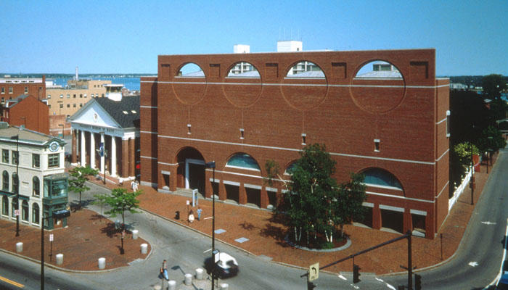
₋The Portland Museum of Art, or PMA, is the largest and oldest public art institution in the U.S. state of Maine. Founded as the Portland Society of Art in 1882. It is located in the downtown area known area The Arts District in Portland, Maine.
₋The PMA used a variety of exhibition spaces until 1908; that year Margaret Jane Mussey Sweat bequeathed her three-story mansion, now known as the McLellan House, and sufficient funds to create a gallery in memory of her late husband, Lorenzo De Medici Sweat, who was a U.S. Representative. Noted New England architect John Calvin Stevens designed the L. D. M. Sweat Memorial Galleries, which opened to the public in 1911.
₋Over the next 65 years, as the size and scope of the exhibitions expanded, the limitations of the Museum's galleries, storage, and support areas became apparent. In 1976, Maine native Charles Shipman Payson promised the Museum his collection of 17 paintings by Winslow Homer. Recognizing the Museum's physical limitations, he also gave $8 million toward the building of an addition to be designed by Henry Nichols Cobb of I. M. Pei & Partners. Construction began on the Charles Shipman Payson Building in 1981, and within two years the $8.2 million facility was opened to the public.
₋Payson's gift of the Homer paintings served as a catalyst for the Museum's expansion as well as for significant long-term loans and outright gifts to the Museum. In direct response to the Payson gift, the 1979 gift of the Hamilton Easter Field Art Foundation Collection added more than 50 paintings, sculptures, and works on paper by American modernists to the collection. In 1991, the Joan Whitney Payson Collection (owned by Charles Payson's wife Joan Whitney, a Whitney family heiress and New York City socialite) of 20 impressionist and post-impressionist works of art was given to the Museum on permanent loan. In 1996, Elizabeth B. Noyce, art collector and Maine philanthropist, bequeathed 66 works of American art, which is the most extensive and diverse gift of American art ever presented to the Museum.
₋The PMA attracts approximately 140,000 visitors a year, and has around 8,500 members.
₋Address: 7 Congress St, Portland, ME 04101, United States
₋Phone: +1 207-775-6148
₋Website: https://www.portlandmuseum.org/
3.Victoria Mansion
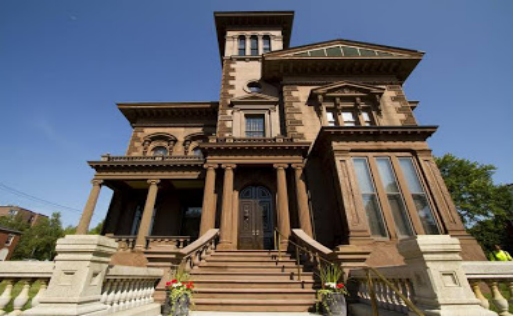
₋Victoria Mansion, also known as the Morse-Libby House or Morse-Libby Mansion, is a landmark example of American residential architecture located in downtown Portland, Maine, United States. The brownstone exterior, elaborate interior design, opulent furnishings and early technological conveniences provide a detailed portrait of lavish living in nineteenth-century America. It was declared a National Historic Landmark in 1971 for its architectural significance as a particularly well-preserved Italianate mansion.
₋This stately brownstone Italianate villa was completed in 1860 as a summer home for hotelier Ruggles Sylvester Morse. Morse had left Maine to make his fortune in hotels in New York, Boston and New Orleans. The house was designed by the New Haven architect Henry Austin. Its distinctive asymmetric form includes a four-story tower, overhanging eaves, verandas, and ornate windows. The frescoes and trompe l’oeil wall decorations were created by the artist and decorator Giuseppe Guidicini.
₋The building is recognized as one of the finest, and least-altered examples of a large Italianate brick/brownstone home in the United States. Gustave Herter created the interiors in a range of styles, and this house is his earliest known and only intact commission. Due to donations by the Libby family, 97 percent of the original contents survive, including Herter furniture, elaborate wall paintings, artworks, carpets, gas lighting fixtures, stained glass, porcelain, silver, and glassware.
₋The house has twin sinks in the guest bedroom on the second floor; a Turkish smoking room, which is one of the first example of Islamic architecture in the United States; carved marble fireplaces; and a flying staircase. When designing the home, Morse incorporated features from his luxury hotels, including the large and tall entryway, and wall-to-wall carpeting. The house used some of the latest technologies of the era (some of which he also took from his hotels), such as central heating, gas lighting, hot and cold running water, and a servant call system. As part of a new and unique design, the water for the house was provided by gutters in the tower and third floor, which ran down through pipes into all the rooms, with separate pipes for heated water, which was heated using coal, and another for cold water.
₋Morse lived in the house until his death in 1893. A year later, the house and its contents were sold by his wife to Joseph Ralph Libby, a Portland merchant and department store owner. The Libby family occupied the house for over 30 more years, until 1928, without making significant changes to it. However, one significant change made was the repainting of the green room in white, which restorationists were unable to restore once it became a museum.
₋Address: 109 Danforth St, Portland, ME 04101, United States
₋Opened: 1860
₋Phone: +1 207-772-4841
₋Website: https://victoriamansion.org/event/victoria-mansion-annual-christmas-gala/
VI.History
₋Native Americans, originally called the Portland peninsula Machigonne ("Great Neck"). Portland was named for the English Isle of Portland, and the city of Portland, Oregon, was in turn named for Portland, Maine. The first European settler was Capt. Christopher Levett, an English naval captain granted 6,000 acres (2,400 ha) in 1623 to found a settlement in Casco Bay. A member of the Council for New England and agent for Ferdinando Gorges, Levett built a stone house where he left a company of ten men, then returned to England to write a book about his voyage to bolster support for the settlement. Ultimately, the settlement was a failure and the fate of Levett's colonists is unknown. The explorer sailed from England to the Massachusetts Bay Colony to meet John Winthrop in 1630, but never returned to Maine. Fort Levett in the harbor is named for him.
₋The peninsula was settled in 1632 as a fishing and trading village named Casco. When the Massachusetts Bay Colony took over Casco Bay in 1658, the town's name changed again to Falmouth. In 1676, the village was destroyed by the Abenaki during King Philip's War. It was rebuilt. During King William's War, a raiding party of French and their native allies attacked and largely destroyed it again in the Battle of Fort Loyal (1690).
₋On October 18, 1775, Falmouth was burned in the Revolution by the Royal Navy under command of Captain Henry Mowat. Following the war, a section of Falmouth called The Neck developed as a commercial port and began to grow rapidly as a shipping center. In 1786, the citizens of Falmouth formed a separate town in Falmouth Neck and named it Portland, after the isle off the coast of Dorset, England. Portland's economy was greatly stressed by the Embargo Act of 1807 (prohibition of trade with the British), which ended in 1809, and the War of 1812, which ended in 1815.
₋In 1820, Maine was established as a state with Portland as its capital. In 1832, the capital was moved north and East to Augusta. In 1851, Maine led the nation by passing the first state law prohibiting the sale of alcohol except for "medicinal, mechanical or manufacturing purposes." The law subsequently became known as the Maine law, as 18 states quickly followed. On June 2, 1855, the Portland Rum Riot occurred.
₋In 1853, upon completion of the Grand Trunk Railway to Montreal, Portland became the primary ice-free winter seaport for Canadian exports. The Portland Company manufactured more than 600 19th-century steam locomotives. Portland became a 20th-century rail hub as five additional rail lines merged into Portland Terminal Company in 1911. Following nationalization of the Grand Trunk system in 1923, Canadian export traffic was diverted from Portland to Halifax, Nova Scotia, resulting in marked local economic decline. In the 20th century, icebreakers later enabled ships to reach Montreal in winter, drastically reducing Portland's role as a winter port for Canada.
₋On June 26, 1863, a Confederate raiding party led by Captain Charles Read entered the harbor at Portland leading to the Battle of Portland Harbor, one of the northernmost battles of the Civil War. The 1866 Great Fire of Portland, Maine, on July 4, 1866, ignited during the Independence Day celebration, destroyed most of the commercial buildings in the city, half the churches and hundreds of homes. More than 10,000 people were left homeless.
₋By act of the Maine Legislature in 1899, Portland annexed the city of Deering, despite a vote by Deering residents rejecting the annexation, thereby greatly increasing the size of the city and opening areas for development beyond the peninsula.
₋The construction of The Maine Mall, an indoor shopping center established in the suburb of South Portland, during the 1970s, economically depressed downtown Portland. The trend reversed when tourists and new businesses started revitalizing the old seaport, a part of which is known locally as the Old Port. Since the 1990s, the historically industrial Bayside neighborhood has seen rapid development, including attracting a Whole Foods and Trader Joes supermarkets, as well as Baxter Academy for Technology and Science, an increasingly popular charter school. Other rapidly developing neighborhoods include the India Street neighborhood near the Ocean Gateway and Munjoy Hill, where many modern condos have been built. The Maine College of Art has been a revitalizing force downtown, attracting students from around the country. The historic Porteous building on Congress Street was restored by the College. Portland is known as a very walkable city, offering many opportunities for walking tours that feature its maritime and architectural history.
VII.Other Information
₋Fire department
₋The Portland Fire Department (PFD) provides fire protection and emergency medical services to the city of Portland 24/7, 365. Established on March 29, 1768, the PFD is made up of over 230 paid, professional firefighters and operates out of 7 Fire Stations, located throughout the city, in addition to Fire Stations staffed by "on-call" firefighters on Peaks Island; Great Diamond Island; Cushing Island; and Cliff Island. The Portland Fire Department also operates an Airport Division Station at 1001 Westbrook St., at the Portland International Jetport, and a Marine Division Station, located at 54 Commercial St. The PFD operates a 4 Platoon shift schedule. Each platoon works for 24 hours followed by one day off. They then work another 24 hour shift followed by 5 days off. The cycle then repeats.
₋The Portland Fire Department operates a fire apparatus fleet of 5 Engine Companies; 4 Ladder Companies (including 3 Quints); 1 Rescue Company; 1 Hazardous Materials (Haz-Mat.) Unit; 1 Confined-Space Rescue Unit; 5 ARFF Crash Rescue Units; 3 Marine Units (Fireboats); 5 MEDCU Units (Ambulances); and numerous special, support, and reserve units. Island "call" firefighters man a total of 4 Engines, 1 Ladder, 4 Water Tank Units, and 3 MEDCU Units (Ambulances).
₋Each frontline fire company is staffed by 1 Officer and 2 Firefighters each shift. Each MEDCU Unit (Ambulance) is staffed by 2 Firefighters (1 Paramedic and 1 AEMT) each shift. The Marine Division is staffed by 1 Officer and 2 Firefighters each shift, who also cross-staff Engine 37 in the event of a structural fire in the city not requiring a Marine Unit. Each platoon has an on duty Deputy Chief, Car 32, who is responsible for day-to-day operations of the shift.
₋The firefighters are members of IAFF Local 740.
₋Roads
₋Portland is accessible from I-95 (the Maine Turnpike), I-295, and US 1. U.S. Route 302, a major travel route and scenic highway between Maine and Vermont, has its eastern terminus in Portland. State Routes include SR 9, SR 22, SR 25, SR 26, SR 77, and SR 100. SR 25 Business goes through southwestern Portland.
₋Intercity buses and trains
₋Amtrak's Downeaster service offers five daily trains connecting the city with eight towns and cities to the south, ending at Boston's North Station. Trains, with the exception of one weekend trip, also go north to Freeport and Brunswick.
₋Concord Coach Lines bus service connects Portland to 14 other communities in Maine as well as to Boston's South Station and Logan Airport. Both the Downeaster and the Concord Coach Lines can be found at the Portland Transportation Center on Thompsons Point Road, in the Libbytown neighborhood. Greyhound Lines on Saint John Street connects to 17 Maine communities and to more than 3,600 U.S. destinations.
₋A carsharing service provided by Uhaul Car Share is available. Both Uber and Lyft operate here. The city bus service is provided by Greater Portland Metro.
₋Airports
₋Commercial air service is available at the Portland International Jetport, located in Stroudwater, west of the city's downtown district. American, Southwest, JetBlue, Delta, and United Airlines service the airport. Direct flights are available to Atlanta, Baltimore, Charlotte, Chicago, Detroit, Philadelphia, New York, Newark, Sarasota, and Washington D.C.
₋Water transportation
₋The Port of Portland is the second-largest cruise and passenger destination in the state (next to Bar Harbor) and is served by the Ocean Gateway International Marine Passenger Terminal. Ferry service is available year-round to many destinations in Casco Bay. From 2006 to 2009, Bay Ferries operated a high speed ferry called The Cat featuring a five-hour trip to Yarmouth, Nova Scotia, for summer passengers and cars. In years past the Scotia Prince Cruises trip took eleven hours. A proposal to replace the defunct Nova Scotia ferry service was rejected in 2013 by the province. From May 15, 2014, until October 2015, the cruise ship ferry Nova Star made daily trips to Yarmouth, Nova Scotia. Due to poor passenger numbers and financial problems, Nova Scotia selected Bay Ferries, the prior operator of The Cat, to operate the service starting in 2016, citing the company's experience and industry relationships. Nova Star officials pledged a smooth transition to the new operator. The Nova Star was later ordered seized by federal marshals for nonpayment of bills.
₋Bay Ferries announced on March 24, 2016, the charter of the former Hawaii Superferry boat HST-2 from the US Navy for the Portland-Yarmouth service for two years. Bay Ferries signed a 10-year deal with Nova Scotia to run the ferry route, which will take about five and a half hours each way. They stated that the boat would be renamed The Cat and that service would begin around June 15, after refitting in South Carolina. There is still a dispute as to whether the ferry will be permitted to carry trucks, desired by Nova Scotia businesses but opposed by the City of Portland.
₋The Casco Bay Lines operate several passenger ferries with dozens of trips every day year-round to the major populated islands of Casco Bay. The service to Peaks Island also provides an auto ferry for most of its schedule.
VIII.Contact Information
Government
Type: City council and city manager
City manager: Jon Jennings
Mayor: Kate Snyder:
City Hall
Physical Address:
389 Congress Street
Portland, ME 04101
Phone:
207-874-8685
Email: cityclerk@portlandmaine.gov
Website: https://www.portlandmaine.gov/Directory.aspx?did=11
